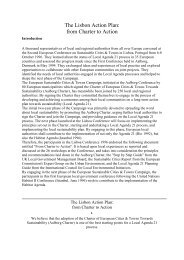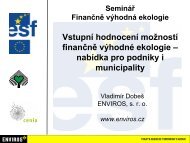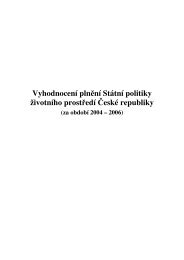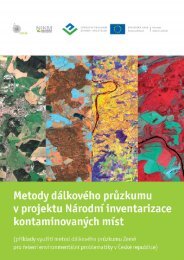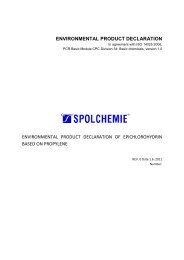Environmental Technologies and Eco-innovation in the Czech ...
Environmental Technologies and Eco-innovation in the Czech ...
Environmental Technologies and Eco-innovation in the Czech ...
You also want an ePaper? Increase the reach of your titles
YUMPU automatically turns print PDFs into web optimized ePapers that Google loves.
The effects of <strong>the</strong> application of biotechnological additives on <strong>the</strong> emissions of<br />
ammonia, carbon dioxide, nitrogen oxide <strong>and</strong> hydrogen sulphide were monitored. The<br />
experiment revealed that by us<strong>in</strong>g biotechnological additives, a reduction <strong>in</strong> <strong>the</strong><br />
emissions of all <strong>the</strong> aforementioned gases can occur <strong>and</strong> <strong>in</strong> case of ammonia, by an<br />
average of 30%.<br />
Immediately after <strong>the</strong> application of some additives, <strong>the</strong>re was an <strong>in</strong>crease <strong>in</strong><br />
emissions followed by a reduction. The effect may be used <strong>in</strong> biogas production.<br />
Selected biotechnological additives may be also applied <strong>in</strong> aerobic controlled highspeed<br />
compost<strong>in</strong>g. The additives stimulate <strong>the</strong>rmophilic 6 bacteria <strong>in</strong>to greater activity<br />
<strong>and</strong> propagation, which accelerates <strong>the</strong> entire compost<strong>in</strong>g process. At <strong>the</strong> same<br />
time, <strong>the</strong>y suppress emissions, especially of those of noxious smells.<br />
TABLE 7 | Proven biotechnological additives that reduce ammonia emissions [%]<br />
Additive name Area of use NH 3 emission reduction<br />
Amalgerol Classic<br />
Additives <strong>in</strong> feed-water <strong>and</strong> feed<strong>in</strong>g,<br />
for treat<strong>in</strong>g slurry <strong>and</strong> muck <strong>in</strong> poultry,<br />
40<br />
pig <strong>and</strong> cattle breed<strong>in</strong>g.<br />
AROMEX SOLID Plus Additives <strong>in</strong> pig feed. 48<br />
BIOSTRONG 510 Additives for poultry feed. 48<br />
SEKOL – JALKA<br />
Additives for treat<strong>in</strong>g sties <strong>and</strong> slurry<br />
reservoirs <strong>in</strong> pig breed<strong>in</strong>g.<br />
32<br />
MEX – Yucca DRY Additives for add<strong>in</strong>g <strong>in</strong> pig feed/poultry feed. 31/38<br />
SOURCE | The Research Institute of Agricultural Eng<strong>in</strong>eer<strong>in</strong>g<br />
Note: The table conta<strong>in</strong>s <strong>the</strong> most frequently used <strong>and</strong> <strong>the</strong> most efficient biotechnological additives.<br />
In <strong>the</strong> <strong>Czech</strong> Republic, SEKOL – JALKA is produced. It reduces ammonia emissions by up to 32%.<br />
4.2 | Spray<strong>in</strong>g technology<br />
Spray<strong>in</strong>g technology treats air <strong>in</strong> livestock stables, meat-process<strong>in</strong>g facilities, <strong>in</strong><br />
<strong>the</strong> lea<strong>the</strong>r <strong>and</strong> textile <strong>in</strong>dustries, sanitation companies, <strong>in</strong> waste water treatment<br />
plants, etc. Air <strong>in</strong> <strong>the</strong>se facilities is polluted by sulphur gases, ammonia <strong>and</strong> o<strong>the</strong>r<br />
malodorous substances. Water with a special concentrate that decomposes air-borne<br />
6 <strong>the</strong>rmophilic – thriv<strong>in</strong>g at relatively high temperatures<br />
58 | 59




